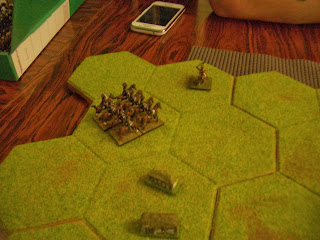 |
| The operational area, Hamelin, on the River Weser. |
I originally set this up as two sided game, but there is so much that can go wrong with an air assault it seemed to fit better as a team game and I also thought NATO has had quite enough of being stomped all over by the opening Warpac attack. In this initial game I just wanted to set the scene for this particular airhead and make sure they had a reasonable chance of getting on the ground, we can pick up any counter attacks/reliefs etc in later games.
I ran it as a team planning game by email with the actual drop being executed on game night, with a bit of 'run up to war' stuff thrown in. Main soviet briefing is reproduced below.
Into the Void, June 31st 1981
General
Briefing
The Soviet invasion of Iran a week
earlier and subsequent exchanges of fire with US forces in the Gulf prompted
the Soviet leadership to initiate an all out attack on NATO to preserve the
integrity of the USSR. In the BAOR sector covering Hannover ,
NATO forces had barely had time to mobilise to war strength and their assembly
positions before Soviet tanks were rolling over the border and the sky was
black with Warpac aircraft.
Warpac
briefing
In support of the counter offensive
against NATO aggression, the VDV is conducting a series of deep operational (50-75km
deep) and strategic (100-150km deep) air landings to sieze key terrain
locations. In support of the attack by 3rd Guards Shock Army, 34th
Air Assault Brigade will size a bridgehead designated by the Centre over the
Weser.
These units will attack prior to the
main offensive, and the initial parachute wave of the deep air assault will conducted
along the entire front will be conducted using fast transports including
hardened civilian airliners. The depth of the attack renders helicopter
insertion impractical. The initial attack will be conducted within 30 minutes
of dawn (either way).
Secure a bridgehead on the west side
of the Weser in the vicinity of Hamelin, secure bridges over the river both to
deny them to the enemy and allow our own forces to use them, clear out any
enemy local defences forces. Prepare a secure defensive perimeter and plan on
being relieved by ground forces in 2-3
days.
Forces
(D8, high morale
unless indicated otherwise)
34th
Air Assault Brigade
Bde HQ plus motorised engineer, atgw
and recce companies.
3 x parachute battalions (2 companies
ea), 1 x mechanised battalion (2 x company BMD)
Paras delivered via paradrop from fast
transports. Antonov transports for BHQ and Mech Bn, Antonovs may land on open
roads (minimum 1km length, ideally 2km) if they are prepared by paras first.
Fighter escort will be available for
the Antonovs.
Ground attack aircraft will be
available for ground support, including preparatory airstrikes if desired.
Intelligence may be gathered prior to
the op by air recce, ground agents, inspection teams. A spetznaz team may be
inserted a few days prior to hostilites, including German speakers if desired.
Excessive interest in the area may provoke a defensive response.
Terrain
Villages and towns provide concealment
and cover (-1 to hit), woods provide concealment.
Hills are rugged and are bad going,
stationary units may find concealment on them. Marshes are a serious impediment
to vehicular movement.
Weather
The weather is good.



















































